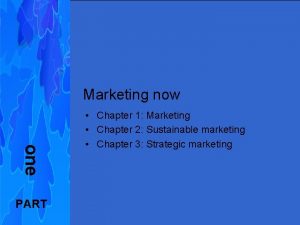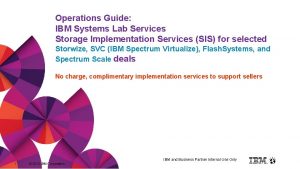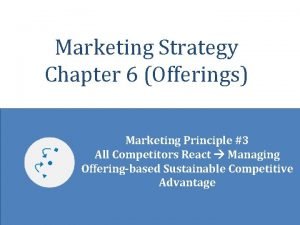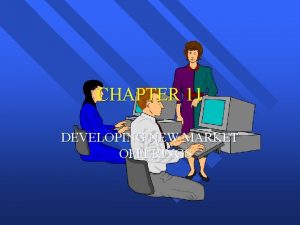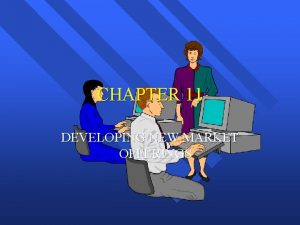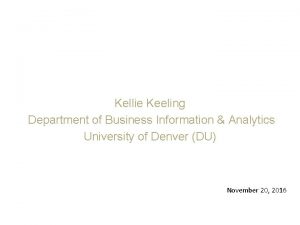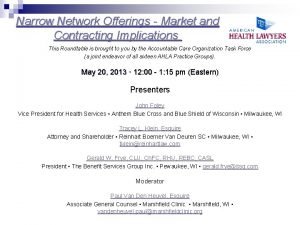1 20 Introducing New Market Offerings Chapter Questions


































- Slides: 34

1 20 Introducing New Market Offerings

Chapter Questions § § § What challenges does a company face in developing new products and services? What organizational structures and processes do managers use to oversee new-product development? What are the main stages in developing new products and services? Copyright © 2011 Pearson Education, Inc. Publishing as Prentice Hall 20 -2

Chapter Questions § § What is the best way to manage the newproduct development process? What factors affect the rate of diffusion and consumer adoption of newly launched products and services? Copyright © 2011 Pearson Education, Inc. Publishing as Prentice Hall 20 -3

Categories of New Products New to the World Additions Improvements Repositionings Cost reductions Copyright © 2011 Pearson Education, Inc. Publishing as Prentice Hall 20 -4

The Innovation of Wii Copyright © 2011 Pearson Education, Inc. Publishing as Prentice Hall 20 -5

Factors That Limit New Product Development § § § § Shortage of ideas Fragmented markets Social and governmental constraints Cost of development Capital shortages Faster required development time Shorter product life cycles Copyright © 2011 Pearson Education, Inc. Publishing as Prentice Hall 20 -6

Table 201. Finding One Successful Product Copyright © 2011 Pearson Education, Inc. Publishing as Prentice Hall 20 -7

What is a Venture Team? § A venture team is a cross-functional group charged with developing a specific product or business. Copyright © 2011 Pearson Education, Inc. Publishing as Prentice Hall 20 -8

Criteria for Staffing Venture Teams § § § Desired team leadership style Desired level of leader expertise Team member skills and expertise Level of interest in concept Potential for personal reward Diversity of team members Copyright © 2011 Pearson Education, Inc. Publishing as Prentice Hall 20 -9

Figure 20. 1 New-Product Development Decision Process Copyright © 2011 Pearson Education, Inc. Publishing as Prentice Hall 20 -10

Ways to Find Great New Ideas § § § Run informal sessions with customers Allow time off for technical people to putter on pet projects Make customer brainstorming a part of plant tours Survey your customers Undertake “fly on the wall” research to customers Copyright © 2011 Pearson Education, Inc. Publishing as Prentice Hall 20 -11

More Ways to Find Great Ideas § § § Use iterative rounds with customers Set up a keyword search to scan trade publications Treat trade shows as intelligence missions Have employees visit supplier labs Set up an idea vault Copyright © 2011 Pearson Education, Inc. Publishing as Prentice Hall 20 -12

Drawing Ideas from Customers § § Observe customers using product Ask customers about problems with products Ask customers about their dream products Use a customer advisory board or a brand community of enthusiasts to discuss product Copyright © 2011 Pearson Education, Inc. Publishing as Prentice Hall 20 -13

Demand-First Innovation and Growth (DIG) Framework Demand Landscape Opportunity Space Strategic Blueprint Copyright © 2011 Pearson Education, Inc. Publishing as Prentice Hall 20 -14

Idea Generation: Creativity Techniques § § § Attribute listing Forced relationships Morphological analysis Reverse assumption analysis New contexts Mind mapping Copyright © 2011 Pearson Education, Inc. Publishing as Prentice Hall 20 -15

Lateral Mapping § § § Gas stations + food Cafeteria + Internet Cereal + snacking Candy + toy Audio + portable Copyright © 2011 Pearson Education, Inc. Publishing as Prentice Hall 20 -16

Table 20. 2 Product Idea Rating Device Copyright © 2011 Pearson Education, Inc. Publishing as Prentice Hall 20 -17

Figure 20. 2 Forces Fighting New Ideas Copyright © 2011 Pearson Education, Inc. Publishing as Prentice Hall 20 -18

Figure 20. 3 Product and Brand Positioning Copyright © 2011 Pearson Education, Inc. Publishing as Prentice Hall 20 -19

Concept Testing § § § Communicability and believability Need level Gap level Perceived value Purchase intention User targets, purchase occasions, purchasing frequency Copyright © 2011 Pearson Education, Inc. Publishing as Prentice Hall 20 -20

Figure 20. 4 Conjoint Analysis Copyright © 2011 Pearson Education, Inc. Publishing as Prentice Hall 20 -21

Figure 20. 5 Utility Functions Based on Conjoint Analysis Copyright © 2011 Pearson Education, Inc. Publishing as Prentice Hall 20 -22

Figure 20. 6 Product Life-Cycle Sales for Three Types of Products Copyright © 2011 Pearson Education, Inc. Publishing as Prentice Hall 20 -23

Table 20. 3 Projected Five-Year Cash Flow Statement Copyright © 2011 Pearson Education, Inc. Publishing as Prentice Hall 20 -24

Prototype Testing § § § Alpha testing Beta testing § Rank-order method § Paired-comparison method § Monadic-rating method Market testing Copyright © 2011 Pearson Education, Inc. Publishing as Prentice Hall 20 -25

Consumer Goods Market Testing § § Sales-Wave Research Simulated Test Marketing Controlled Test Marketing Test Markets Copyright © 2011 Pearson Education, Inc. Publishing as Prentice Hall 20 -26

Test Market Decisions § § § How many test cities? Which cities? Length of test? What information to collect? What action to take? Copyright © 2011 Pearson Education, Inc. Publishing as Prentice Hall 20 -27

Timing of Market Entry § § § First entry Parallel entry Late entry Copyright © 2011 Pearson Education, Inc. Publishing as Prentice Hall 20 -28

What is Adoption? Adoption is an individual’s decision to become a regular user of a product. Copyright © 2011 Pearson Education, Inc. Publishing as Prentice Hall 20 -29

Stages in the Adoption Process Awareness Interest Evaluation Trial Adoption Copyright © 2011 Pearson Education, Inc. Publishing as Prentice Hall 20 -30

Figure 20. 7 Adopter Categorization on the Basis of Relative time of Adoption Copyright © 2011 Pearson Education, Inc. Publishing as Prentice Hall 20 -31

Characteristics of an Innovation § § § Relative advantage Compatibility Complexity Divisibility Communicability Copyright © 2011 Pearson Education, Inc. Publishing as Prentice Hall 20 -32

For Review § § § What challenges does a company face in developing new products and services? What organizational structures and processes do managers use to oversee new-product development? What are the main stages in developing new products and services? Copyright © 2011 Pearson Education, Inc. Publishing as Prentice Hall 20 -33

For Review § § What is the best way to manage the newproduct development process? What factors affect the rate of diffusion and consumer adoption of newly launched products and services? Copyright © 2011 Pearson Education, Inc. Publishing as Prentice Hall 20 -34
 Introducing new market offerings ppt
Introducing new market offerings ppt Market offerings are limited to physical products
Market offerings are limited to physical products Introducing and naming new products and brand extensions
Introducing and naming new products and brand extensions Introducing and naming new products and brand extensions
Introducing and naming new products and brand extensions Market leader challenger follower nicher
Market leader challenger follower nicher Market segmentation lesson plan
Market segmentation lesson plan Politics definition
Politics definition Psychology a journey
Psychology a journey The actual and potential rival offerings
The actual and potential rival offerings The actual and potential rival offerings and substitutes
The actual and potential rival offerings and substitutes Lsu law school tuition
Lsu law school tuition Ellen white on tithes and offerings
Ellen white on tithes and offerings Consulting service offerings
Consulting service offerings Equity international management
Equity international management Ibm systems lab services
Ibm systems lab services Offerings marketing
Offerings marketing Chapter 16 toward a new heaven and a new earth
Chapter 16 toward a new heaven and a new earth Quote signal phrases
Quote signal phrases Introduction to english linguistics exercises answers
Introduction to english linguistics exercises answers Introducing james joyce
Introducing james joyce Quote explanation starters
Quote explanation starters Transition words to introduce a counterclaim
Transition words to introduce a counterclaim Unit 1 about myself
Unit 1 about myself Talk boost tracker
Talk boost tracker Ma
Ma Diamante poem meaning
Diamante poem meaning Introduction of digestive system
Introduction of digestive system Company profile of kfc
Company profile of kfc Integers essential questions
Integers essential questions Who isp
Who isp Quote citation
Quote citation Templates for introducing quotations
Templates for introducing quotations Introducing windows 7
Introducing windows 7 Who invented the metric system
Who invented the metric system Short bio yourself
Short bio yourself

